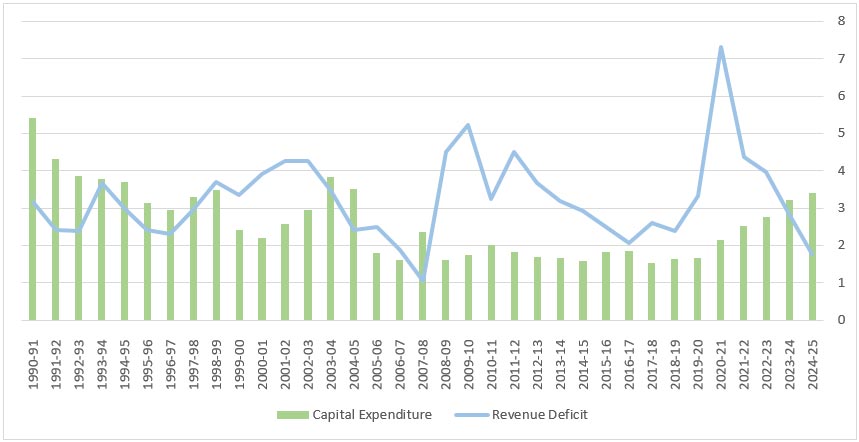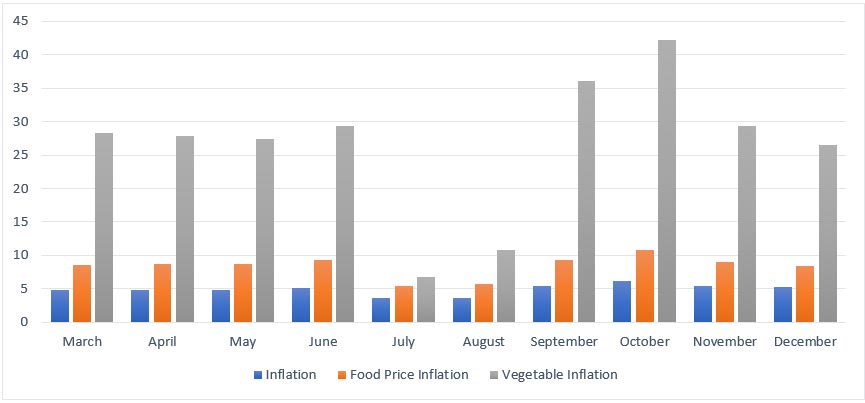
Image Source: Getty
This is the first piece in a three-part series discussing India’s budget imperatives.
The Union Budget 2025-26, to be presented on 1 February 2025, will set the groundwork for the government’s fiscal plans as India continues its post-pandemic economic recovery while striving for long-term fiscal sustainability. Central to this budget is the imperative of fiscal consolidation, a strategy to reduce the fiscal deficit and strengthen macroeconomic stability. However, fiscal prudence should not constrain the growth potential or developmental objectives. This 3-part analysis delves into how the Budget should focus on and balance between three key areas—fiscal consolidation, employment and developmental expenditure.
Central to this budget is the imperative of fiscal consolidation, a strategy to reduce the fiscal deficit and strengthen macroeconomic stability.
What is fiscal consolidation?
The fiscal deficit is the excess of the total expenditure of the government over total receipts excluding borrowings, i.e., how much the government needs to borrow to finance its expenditure. The Fiscal Responsibility and Budget Management Act (FRBMA), 2003 mandated the government to restrict the fiscal deficit up to 3 percent of GDP by 31 March 2021. After the pandemic-induced spike to 9.16 percent of the gross domestic product (GDP), the fiscal deficit is projected to moderate to 4.94 percent in 2024-25, with the government targeting further reductions. To attain a deficit level lower than 4.5 percent by 2026-27, the government will be pursuing fiscal consolidation, i.e., reducing the fiscal deficit.
Figure 1: Fiscal Deficit as a percentage of GDP (since 1990-91)

Source: RBI
The implications of fiscal consolidation on growth and welfare need to be assessed. The fiscal deficit can be narrowed via two avenues—curtailing expenditure or enhancing revenue. Either method will directly affect domestic demand, having short-run contractionary effects. A reduction in government expenditure will lower domestic demand and might cause private investment to crowd out, resulting in output contraction. On the other hand, a boost in revenue financed by higher taxes, will moderate economic output due to lower private spending and cooled down corporate activity. However, despite these short-run consequences, fiscal consolidation has long-lasting positive effects. Lower government borrowing makes resources available for private investment and enhances macroeconomic stability through higher business confidence. Further, it increases fiscal sustainability, which encourages longer horizon investments stemming from confidence in the government’s policy continuity.
A boost in revenue financed by higher taxes, will moderate economic output due to lower private spending and cooled down corporate activity.
The short-run negative consequences of fiscal consolidation may be offset by adjustments in expectations about future sustainability and economic performance. However, some demanding prerequisites allow this counter-effect. First, the consolidation plan should be structured, laying a long-term plan that will increase fiscal debt sustainability and bolster economic performance. Second, the consolidation plan should focus on promoting employment and fuelling savings. Third, the proportion of households who can afford to intertemporally adjust their savings should be high. Finally, the contractionary effects of the consolidation should be balanced out by adjustments in the exchange rate and/or interest rates. The third condition entails complex consequences to the fiscal policy of the Indian populace, and, hence, demands greater attention.
Consolidation adjustments through tax hikes lead to recessions whereas economic loss (in terms of output) associated with expenditure adjustments is relatively low. Private investment, which is the most reactive component to consolidation adjustments, recovers quickly after spending cuts but takes a deep dive if tax hikes are implemented. Notwithstanding the ambiguity on the correct instrument of choice for consolidation, it is evident that, despite the short-run repercussions, consolidation leads to sustainable growth in the long-run through lower interest rates, weaker exchange rates and the consequent expansion of exports.
A possible approach to fiscal consolidation
Fiscal consolidation can happen in tandem with high growth rates by gradually reducing the revenue deficit. A diminished revenue deficit would allow the government to undertake significant capital expenditure (capex) without pushing the fiscal deficit. This is a possible policy option as the revenue deficit has been declining in the recovery years from 4.37 percent in 2020-21 to a projected 1.78 percent in 2024-25. Figure 2 shows that this has, in fact, been the government’s strategy in the post-pandemic recovery period. Lower revenue deficit has been matched with increased capital expenditure since 2020-21.
Figure 2: Revenue Deficit and Capital Expenditure (as % of GDP)

Source: RBI
Again, lowering the revenue deficit can be attained through lower expenditure or higher receipts. Revenue receipts include tax and non-tax receipts, with the former constituting around 75 percent of the whole. A higher corporation tax or income tax will inhibit business growth and consumption expenditure respectively. This might also put downward pressure on domestic savings and curb the growth capacity of the economy, from a Neoclassical perspective. Thus, the government should resort to expenditure control. Under revenue expenditure, the highest shares are reserved by interest payments and Grants-in-aid. Grants-in-aid are assistance or transfers made by the Union Government to state governments under various plan and non-plan heads. Given the politically sensitive nature of reorganising expenditure among different activities, the government could incentivise better fiscal management at the state level. This would promote cooperative federalism and ease the burden on central finances.
A concomitant increase in capital expenditure can offset the contractionary effects of the revenue expenditure shortfall. With a multiplier of around 2.45, capex is a highly potent instrument of demand generation. It also adds to productive capacity through infrastructure development, while having a crowding-in effect on private investment. Higher capex can facilitate greater capital receipts in the medium- to long-run, by generating greater revenue through the monetisation of highways and (non-tax revenue) returns from transport. The 2025-26 budget should therefore focus on higher capex and moderate grants to states. Since lower borrowing to finance deficits will mitigate revenue expenditure through lower interest and debt services payments, the government can focus on stabilising expenditure. This can be attempted through constant expenditure across activities and programmes, with no upward revision for the fiscal 2025-26.
Fiscal consolidation and inflation
Inflation has been a persistent concern for both producers and consumers affecting both effective demand and capacity utilisation. Fiscal consolidation can limit inflation and inflation expectations. Theoretically, consolidation financed by debt might not affect real variables, often known as Ricardian Equivalence (RE). Unfortunately, empirical evidence has been found dismissing the applicability of RE in India—government deficits affect contemporaneous private consumption. Thus, it is unlikely that the contractionary effects of consolidation will be limited due to a change in expectations or foresight of economic agents. However, this bodes well for inflation control.
Solidification of private consumption during fiscal consolidation can partly neutralise the contractionary effects of the latter.
During November 2024, professional forecasters expected the rise in inflation to persist till the first quarter of 2025-26. Similarly, households anticipate higher current inflation, with a persistent rise three months and a year ahead. From the household perspective, this might lead to more conservative spending patterns in 2025-26, as they attempt to smoothen their consumption pattern. This could further dampen demand in the next fiscal, curbing growth. However, a fiscal consolidation announcement in the budget, supplemented with necessary reforms, can alleviate household concerns and lower inflation. Solidification of private consumption during fiscal consolidation can partly neutralise the contractionary effects of the latter.
Figure 3: Monthly Inflation Rates (March-December, 2024)

Source: MOSPI
In the current fiscal year, inflation is primarily being driven by skyrocketing vegetable prices. Potato, onion and tomato (POT) inflation has leaked into consumer price index (CPI) inflation and created pressure on household incomes. The high prices have originated from deficiencies and inefficiencies in agricultural markets. A lack of storage facilities, weak linkages along the value chain, and uncompetitive market structures have left producers and consumers susceptible to seasonal variations and price shocks. While fiscal consolidation might ease inflation through spending cuts and expectation revisions, long-term expenditure allocation towards agricultural market reforms is needed to address inflation volatility.
Agricultural spending can buttress rural demand and curb contraction due to consolidation.
Concluding remarks
The 2025-26 Budget should include greater outlays on agricultural schemes. For instance, the Rashtriya Krishi Vikas Yojana (RKVY), which focuses on supporting infrastructure in agriculture, including cold storage, post-harvest management, and mechanisation was allocated INR 7,553 crore in 2024-25. This along with other schemes such as Pradhan Mantri Krishi Sinchai Yojana (PMKSY) and Krishonnati Yojana, which focus on enhancing agricultural productivity, should be the subject of focus, given the consistent contribution of agriculture to GDP. Agricultural spending can buttress rural demand and curb contraction due to consolidation.
Fiscal consolidation is more than a numbers game. It requires prudence, foresight, and a commitment to equitable growth. While curbing expenditure or raising revenue presents immediate challenges, a well-structured fiscal framework can unlock long-term benefits such as lower borrowing costs, enhanced business confidence, and increased fiscal space for critical investments. The 2025-26 Budget must prioritise targeted capital expenditure, promote cooperative federalism, and address inflationary pressures through agricultural reforms. These measures will not only support fiscal sustainability but also foster inclusive growth, ensuring that the benefits of economic recovery are shared across sectors and society.
Arya Roy Bardhan is a Research Assistant at the Observer Research Foundation
The views expressed above belong to the author(s). ORF research and analyses now available on Telegram! Click here to access our curated content — blogs, longforms and interviews.







 PREV
PREV


